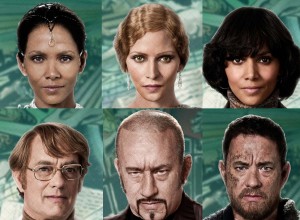Cloud Atlas
Posted on October 25, 2012 at 6:00 pm
 Six nested stories set in the past, present, and future entwine grand themes of the conflicts between those who would oppress and those who demand freedom, those who must create and those who want to repeat what is already there, those who love and those who are afraid to love or be loved. Some in the audience will be enchanted by the grand scope of the story-telling and the intricate details of the mosaic that make up each of the story’s parts. Others will be impatient with the gimmicks and distracted by the prosthetics, wigs, and make-up. Many will grapple with the frustration of experiencing both reactions.
Six nested stories set in the past, present, and future entwine grand themes of the conflicts between those who would oppress and those who demand freedom, those who must create and those who want to repeat what is already there, those who love and those who are afraid to love or be loved. Some in the audience will be enchanted by the grand scope of the story-telling and the intricate details of the mosaic that make up each of the story’s parts. Others will be impatient with the gimmicks and distracted by the prosthetics, wigs, and make-up. Many will grapple with the frustration of experiencing both reactions.
When they made the “Matrix” films, they were known as the Wachowski brothers, Andy and Larry. But since then, Larry has become Lana while resisting terms like “transition” as “complicity in a binary gender narrative.” That clearly fueled the commitment to age, race, and gender fluidity throughout the film. Even the most sharp-eyed cataloger of prosthetic noses and teeth will be surprised as the credits reveal the multiple roles taken by Tom Hanks, Halle Berry, Hugo Weaving (Mr. Smith in the “Matrix” films), Hugh Grant, Jim Sturgess, James Broadbent, Ben Wishaw, Keith David, Doona Bae, and others.
The oldest story, set in the early 19th century and told in the traditional style of ahistorical drama, has Sturgess as a man disturbed by the abuse of slaves in the Pacific who is being poisoned by a doctor (Hanks) he thinks is curing him. His journals become a book on a shelf in the next story, set in the 1930’s, with a musician (Wishaw) writing to the man he loves about assisting a venerated composer and working on his own composition, called “Cloud Atlas.” In the 1970’s, styled to remind us of that era’s “paranoid cinema” films like “The Parallax View” and “The China Syndrome,” an investigative reporter (Berry) gets stuck in an elevator with an elderly scientist who gives her some important information about a nuclear facility. She discovers his 40-years-old correspondence with the musician in his papers. In the present day, we see something of a shaggy dog story as a British publisher (Broadbent) goes on the run from hooligans and ends up having to escape from a “One Flew Over the Cuckoo’s Nest”-style facility.
Two stories are set in the future. The first, in what is now Korea, has a “Blade Runner-“ish society made up of consumers and “fabricants.” One of them sees a movie based on the story of the publisher’s escape (starring Hanks), which helps her understand that she must rebel against the abuses of her society. Her story becomes part of the origin myths of a post-apocalyptic society hundreds of years even farther into the future, where much of humanity has returned to an almost bronze-age level of technology and everyone speaks in a Jar-Jar Binks form of pidgin English that may have worked better on the printed page but on screen is intrusive and overdone.
As the the “Matrix” films, the more specific and concrete it gets, the less resonance it has. Its greatest message about human aspiration and inspiration and connection is in the message as medium. The scope and audacity of this undertaking, the biggest budget independent film in history, with the Wachowskis putting up their own homes to make the final budget numbers, outshines the details that never quite reach the clouds.
Parents should know that this film includes some graphic violence including murders, rape, shoot-outs, knives, arrows, suicide, brutal whipping, poison, car crashes, and a character being thrown off a balcony. Characters are in peril, injured and killed. There are dead bodies with disturbing images, some strong words including f-word and n-word, gay and heterosexual sexual references and explicit situations as well as nudity, crude sexual humor, portrayal of slavery and totalitarianism, smoking, and drug use.
Family discussion: Which of the stories was the most compelling and why? Who was the bravest character? Who learned the most?
If you like this, try: the book by David Mitchell and the “Matrix” movies

Thank you for such a thoughtful review! My kids know they cannot see a movie unless I “check with movie mom first!”
Is it just my computer, or did you not give this movie a rating as far as age (I am assuming mature high schooler) and a grade?
A glitch on my part, Michelle — it’s been corrected and you guessed correctly. Thanks for letting me know and for the kind words. You made my day!